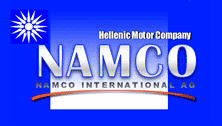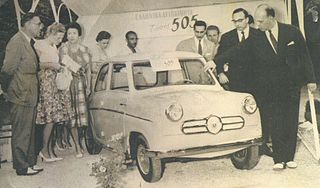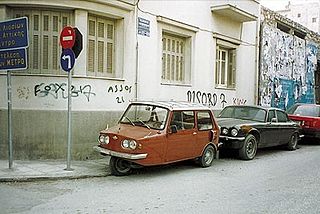
Innocenti was an Italian machinery works, originally established by Ferdinando Innocenti in 1920. Over the years, they produced Lambretta scooters as well as a range of automobiles, mainly of British Leyland origins. The brand was retired in 1996, six years after being acquired by Fiat.
Economy car is a term mostly used in the United States for cars designed for low-cost purchase and operation. Typical economy cars are small, lightweight, and inexpensive to both produce and purchase. Stringent design constraints generally force economy car manufacturers to be inventive. Many innovations in automobile design were originally developed for economy cars, such as the Ford Model T and the Austin Mini.

The Fiat 131 is a family sedan manufactured and marketed by Fiat from 1974 to 1984 after its debut at the 1974 Turin Motor Show. Available as a two-door and four-door saloon and 5-door estate across a single generation, the 131 succeeded the Fiat 124.

The Fiat 1100 is a small family car produced from 1953 to 1969 by the Italian manufacturer Fiat. It was an all-new unibody replacement for the Fiat 1100 E, which descended from the pre-war, body-on-frame Fiat 508 C Balilla 1100. The 1100 was changed steadily and gradually until being replaced by the new Fiat 128 in 1969. There were also a series of light commercial versions of the 1100 built, with later models called the Fiat 1100T, which remained in production until 1971. The Fiat 1100 D also found a long life in India, where Premier Automobiles continued to build the car until the end of 2000.

The Fiat Fiorino is a small commercial vehicle produced by the Italian car manufacturer Fiat since 1977. Its first two generations have been the panel van derivatives of other small models, such as the Fiat 127 and Fiat Uno, while the current third generation was developed jointly with PSA Peugeot Citroën, and is based on the Fiat Small platform.

Biotechnia Ellinikon Trikyklon, or BET, was a small vehicle manufacturer founded in Athens by Petros Konstantinou. It was one of several manufacturers - the first appearing in the early 1940s - that converted BMW or other motorcycles into light utility three-wheelers. In 1965 it entirely designed and built a small five-seat passenger car with a BMW 125cc motorcycle engine. Although the type was certified, only one was built due to problems in availability of parts for further production. Following this design, three-wheeled truck models were developed and produced. A second passenger car model was designed and introduced in 1973, known as model 500, with a Fiat 500cc engine. With metal body, seating up to five passengers and featuring very good road handling, it was a rather advanced three-wheeler for its time. It was certified for production and 15 were built, of which one survives to this date in excellent condition. There were even talks with a South African company involving plans for exports or even transfer of production to that country, but they were never realized. The company ceased production in 1975.

MEBEA was an important Greek vehicle manufacturer, producer of light trucks, passenger automobiles, motorcycles, motorbike engines, agricultural machinery and bicycles.

STYL KAR was named after its founder, the engineer Stylianos Karakatsanis. Its entire history is representative of many Greek companies who were engaged in the construction of simple utility vehicles.

Alta was a Greek manufacturer of light and heavier three-wheeler trucks, motorcycles and passenger cars. Production of motorcycles and three-wheeler trucks with Sachs 50cc engines started in its first factory in Athens in 1962. The 50S motorcycle model was known for its reliability. In 1967 it designed and developed model A700, a heavier three-wheel truck with 2-cylinder BMW 35 hp engine and a payload of 800 kg. The truck, featuring a pleasant design and high reliability became one of the most successful vehicles of its kind in Greece. In 1968 Alta introduced a three-wheel passenger car, model A200. Powered by a Heinkel 200cc engine, the car was based on the German Fuldamobil, but with Alta's own body design. The company moved production to a new, larger factory in Elefsis where it operated until 1978.

Attica was a brand name of vehicles produced by Bioplastic S.A., a company created in Moschato, Athens by Georgios Dimitriadis, a figure in Greek automotive history.

NAMCO is a Greek vehicle manufacturer. It was founded in 1972 by Kontogouris brothers.

Automeccanica was a Greek automobile producing company. Founded in 1979, it was one of the companies that produced the "passenger-utility" type of vehicle popular in Greece at the time for tax categorization reasons. Its creators were former executives of Autokinitoviomihania Ellados a company founded in 1975 to also produce vehicles of this type – it assembled Italian Fissore models based on Fiat products, as well as other Fiat models and variants. Automeccanica followed a different path, building the Zebra model, a passenger-utility car based on the Daihatsu Charade, as well as assembling the Charade itself. In 1985, when the law favoring the Zebra-type vehicles changed, Automeccanica stopped its production and started licence production of the Soviet Lada Niva model, while it developed its own cabrio-version of the car. In 1988 it acquired its former "father" company, Autokinitoviomihania Ellados and the latter's factory in Thiva. Automeccanica went out of the car-construction business in 1995.

MAVA Company was the Greek importer of Renault automobiles. In 1979, it decided to enter the car-production business introducing a passenger-utility car, a type then very popular in Greece for tax cetagorization reasons. MAVA assigned the creation of the car to Georgios Michael, a Greek designer credited with the design of Neorion Chicago, as well as that of several other Greek vehicles. Michael and his team completed the development and prototype construction in record-time and the car, named Farma, was introduced the same year. MAVA had insisted that the car should be presented as a "Renault model" and thus the prototype was tested and approved by the French company.

Motoemil was a Greek truck manufacturer based in Thessaloniki. It was named after Emilios Antoniades who started his business, together with his brother Konstantinos, by constructing crude-made trucks assembled from motorcycle and automobile parts. By the mid-1960s, like other similar Greek manufacturers, they were already developing and building complete "automobile" three-wheeler trucks. Motoemil was one of the first of its kind in Northern Greece and soon became the largest in that region, its products sold throughout the country. The first models used 1200cc Volkswagen air-cooled engines. A completely redesigned, more modern-looking model was introduced in 1970, using a German Ford engine.

Dante Giacosa was an Italian automobile designer and engineer responsible for a range of Italian automobile designs — and for refining the front-wheel drive layout to an industry-standard configuration.

In 2015 Spain produced 2.7 million cars which made it the 8th largest automobile producer country in the world and the 2nd largest car manufacturer in Europe after Germany. The forecast as of 2016 was to produce a total of 2.8 million vehicles from which about 80% is for export. During the first half of 2016, with exports valued over 24 billion euros over that period, the automotive industry accounted for 18.9% of the total Spanish exports.

The Dimitriadis model 505 was a Greek microcar developed in 1958 by G. Dimitriadis, founder of the Bioplastic boat and automobile manufacturer. This car represented his first effort in automobile production, and was presented in a number of exhibitions in Greece. According to Mr. Dimitriadis, its production was eventually considered non-profitable compared to that of three-wheelers. Thus, he switched to the licence production of the German Fuldamobil three-wheeler.

The BET 500 was light car model developed by BET, a small Greek vehicle manufacturer. Introduced in 1973, it used a Fiat 500cc engine, had a metal body and seated up to five passengers. It was certified for production and 15 were built and sold, of which one survives to this date in excellent condition, plus another two in poor condition. Although the car featured good road handling for a 3-wheeler and was roomy for its size, it could find few buyers at these, more prosperous times for Greece, while the company could not secure agreements with banks for favorable loans to potential buyers. Petros Konstantinou, owner of BET, hoped to sell the production rights to other countries; according to him, there were talks with a South African company involving plans for exports or transfer of production to that country, but they were never realized. Another planned version, the BET 600 was not built and the company ceased production altogether in 1975.

Autokinitoviomihania Ellados was founded in Athens in 1975 by a group of Greek businessmen, including the owners of the company importing Fiat in Greece.

Zastava Automobiles was a Serbian car manufacturer, a subsidiary of Group Zastava Vehicles which went bankrupt in May 2017.




















